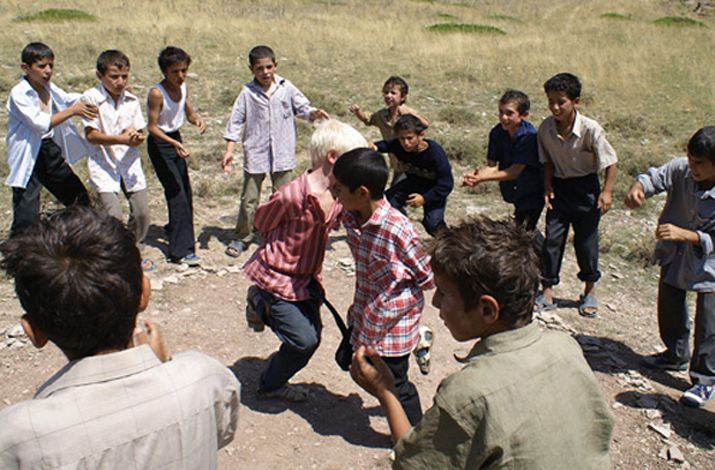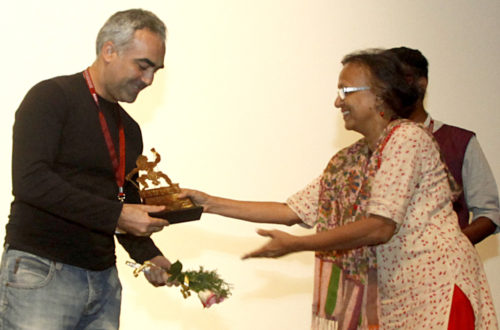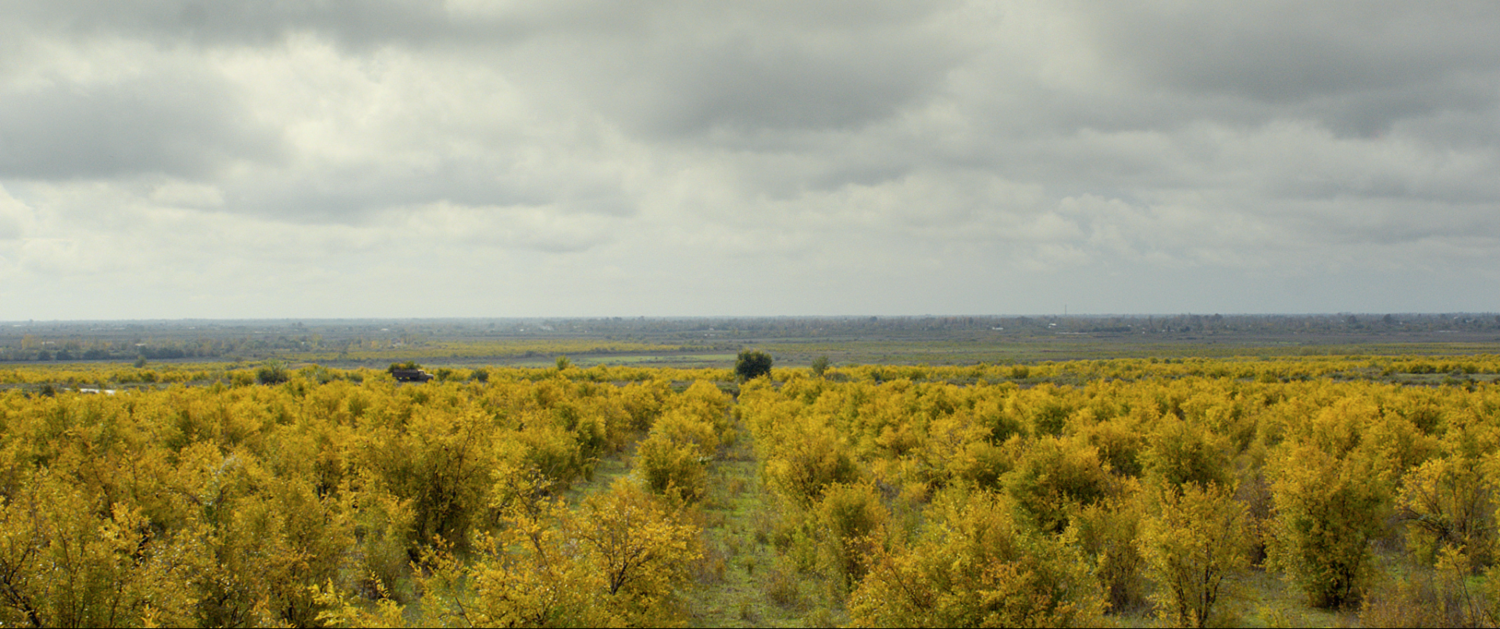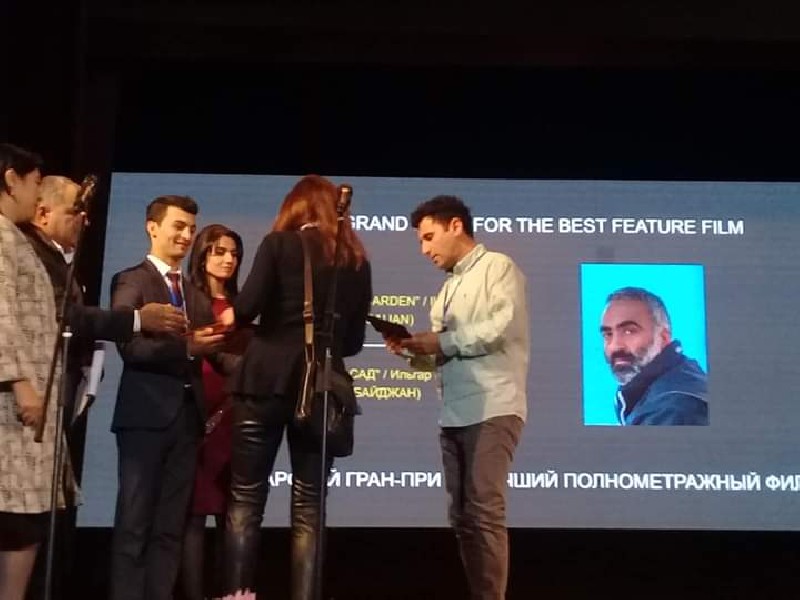
Buta (Azerbaijan, 2011) reviewed by Vlad Strukov © 2013
Buta is an ornament on carpets, fabrics, embroideries, frescoes.
It had been known from times immemorial.
It has polysemantic symbolics.
It is interpreted as a bud, the Sun, a drop of water,
a tongue-flame, an ovary of fruit and many other things.
But mainly it symbolizes life.
From the opening credits of Buta
 Scripted and directed by Ilgar Najaf, Buta was chosen as the Azerbaijani entry in the Best Foreign Language Film category at the 85th Academy Awards. Buta is a nickname of the film’s protagonist, a seven-year old boy, who lives in a remote village in Azerbaijani highlands. Disconnected from the modern world, he and other villagers display a strong connection to their land and to the traditions of their ancestors. The film develops three main plotlines: Buta’s conflict with a group of other boys in the village and his friendship with a little girl, the sister of the main bully, Buta’s opponent; Buta’s grandmother’s re-union with the love of her youth, an elderly man referred to as Grandpa; and a young woman, Grandmother’s apprentice, Gyoncha, and her relationship with a merchant who represents some transnational company that produces soap and shampoo. The three storylines are brought together by the figure of Buta, for whom the other main characters—with the exception of his grandmother of course—function as a surrogate family.
Scripted and directed by Ilgar Najaf, Buta was chosen as the Azerbaijani entry in the Best Foreign Language Film category at the 85th Academy Awards. Buta is a nickname of the film’s protagonist, a seven-year old boy, who lives in a remote village in Azerbaijani highlands. Disconnected from the modern world, he and other villagers display a strong connection to their land and to the traditions of their ancestors. The film develops three main plotlines: Buta’s conflict with a group of other boys in the village and his friendship with a little girl, the sister of the main bully, Buta’s opponent; Buta’s grandmother’s re-union with the love of her youth, an elderly man referred to as Grandpa; and a young woman, Grandmother’s apprentice, Gyoncha, and her relationship with a merchant who represents some transnational company that produces soap and shampoo. The three storylines are brought together by the figure of Buta, for whom the other main characters—with the exception of his grandmother of course—function as a surrogate family.
 Story-telling in the film is compared to weaving: Buta’s grandmother is a carpet maker and also a story-teller. At the start of the film she is shown working on a carpet outside the house; the pattern is just beginning to emerge; towards the end of the film the carpet is finished and the beauty of the ornament is revealed. Predictably it includes buta as its key element. The film might seem to make an obvious connection between weaving and story-telling, and perhaps this is its main message: it encourages the viewer to enjoy the pattern rather than try to guess what the pattern might be. So the film celebrates the slow pace of everyday life and also shows how the mundane is home to the extraordinary. Acceptance and humility are the values the villagers invariably embrace. Their life seems to follow the pattern of buta—an almost circular shape with a curly protrusion on one side—and so combines repetition and difference.
Story-telling in the film is compared to weaving: Buta’s grandmother is a carpet maker and also a story-teller. At the start of the film she is shown working on a carpet outside the house; the pattern is just beginning to emerge; towards the end of the film the carpet is finished and the beauty of the ornament is revealed. Predictably it includes buta as its key element. The film might seem to make an obvious connection between weaving and story-telling, and perhaps this is its main message: it encourages the viewer to enjoy the pattern rather than try to guess what the pattern might be. So the film celebrates the slow pace of everyday life and also shows how the mundane is home to the extraordinary. Acceptance and humility are the values the villagers invariably embrace. Their life seems to follow the pattern of buta—an almost circular shape with a curly protrusion on one side—and so combines repetition and difference.
 From the very outset the film focuses on the exploration of ancient decorative motifs, including buta, which seems to appear everywhere. In the beginning, digitally animated credits are interspersed with scenes of male villagers playing a game that looks similar to polo; the camera picks buta as an element of the ornament on the players’ clothes, on carpets, in the form of a tattoo on a girl’s hand, on a duvet Buta uses in bed; later buta re-appears in the form of a pond where the local boys bathe and in the shape of the stone structure Buta builds on top of a hill. These exterior patterns represent the characters’ interior world: for example, Buta wears a checkered cowboy shirt, with the sharp geometry of this pattern hinting at his maturation, at his developing more masculine, edgy traits of character which contrast with his inner plasticity, symbolized by buta. Therefore, the film is rich in symbols and allegories, and it functions as a cinematic exploration of allegory per se.
From the very outset the film focuses on the exploration of ancient decorative motifs, including buta, which seems to appear everywhere. In the beginning, digitally animated credits are interspersed with scenes of male villagers playing a game that looks similar to polo; the camera picks buta as an element of the ornament on the players’ clothes, on carpets, in the form of a tattoo on a girl’s hand, on a duvet Buta uses in bed; later buta re-appears in the form of a pond where the local boys bathe and in the shape of the stone structure Buta builds on top of a hill. These exterior patterns represent the characters’ interior world: for example, Buta wears a checkered cowboy shirt, with the sharp geometry of this pattern hinting at his maturation, at his developing more masculine, edgy traits of character which contrast with his inner plasticity, symbolized by buta. Therefore, the film is rich in symbols and allegories, and it functions as a cinematic exploration of allegory per se.
Three other poignant symbols in the film are the tree, the river and the carpet. They provide the film with a narrative structure, frame characters’ development and enable an allegorical reading of the events. The river separates the village from the rest of the world; as a symbol of time, the river emphasizes the eternal nature of the conflict; its meandering waters provide Grandma with inspiration when she is working on her carpets.
 Shot from a distance, the tree enters the visual landscape of the film from the very outset. It grows in the middle of a vast field, a solitary reminder of life, transformation, continuity and wisdom. The characters come to the tree at moments of crises, for example, when Buta is bullied by other boys, and it provides them with a spiritual remedy. The tree that grows far off in the field is contrasted with some trees in the village: Grandpa has one, and it symbolizes his love for a woman, and this is where he dies; Grandma has one, and it symbolizes her love for her grandson. She reminds Buta that the tree always blooms on his birthday, and it becomes a symbol of youth, potency and a start of new life.
Shot from a distance, the tree enters the visual landscape of the film from the very outset. It grows in the middle of a vast field, a solitary reminder of life, transformation, continuity and wisdom. The characters come to the tree at moments of crises, for example, when Buta is bullied by other boys, and it provides them with a spiritual remedy. The tree that grows far off in the field is contrasted with some trees in the village: Grandpa has one, and it symbolizes his love for a woman, and this is where he dies; Grandma has one, and it symbolizes her love for her grandson. She reminds Buta that the tree always blooms on his birthday, and it becomes a symbol of youth, potency and a start of new life.
 The carpet is perhaps the central symbolic element in the film. On one level, it is a utilitarian object—hung vertically, it shelters Buta from strong winds; on another level it is an artifact that enables highly ritualized communication—placed horizontally on the ground it becomes a symbol of a young woman’s devotion to a man. Most importantly, the carpet functions as a canvas that characters use to inscribe their feelings and thoughts. If Grandpa needs to restore an ancient mill to complete the circle of his life, Grandma needs to create a beautiful carpet that would “summarize” her life, with all its suffering and happiness. As soon as she finishes one carpet she moves onto the next, using flowers to dye the yarn. When Grandpa dies, Buta finds him lying on a carpet—the viewer has reason to suspect it is the carpet Grandma gave him when they were young.
The carpet is perhaps the central symbolic element in the film. On one level, it is a utilitarian object—hung vertically, it shelters Buta from strong winds; on another level it is an artifact that enables highly ritualized communication—placed horizontally on the ground it becomes a symbol of a young woman’s devotion to a man. Most importantly, the carpet functions as a canvas that characters use to inscribe their feelings and thoughts. If Grandpa needs to restore an ancient mill to complete the circle of his life, Grandma needs to create a beautiful carpet that would “summarize” her life, with all its suffering and happiness. As soon as she finishes one carpet she moves onto the next, using flowers to dye the yarn. When Grandpa dies, Buta finds him lying on a carpet—the viewer has reason to suspect it is the carpet Grandma gave him when they were young.
 The community living in the village is represented as a group of people practicing ancient traditions and beliefs. However, the film has a pseudo-anthropological quality to how it shows the everyday life of the village. It focuses on their practices and rituals, for example, carpet weaving and bread making; the camera celebrates the slow pace of life in showing a solitary figure of an elderly man; the director indulges in long takes of valleys, clouds and hills, and this imagery is unquestionably stunning. Buta makes a point about eschewing all signs of modernity—in fact, the commercial truck gets stuck in mud on the banks of the river, forcing the driver to abandon his vehicle and explore the village on foot. Local women reject his (promotional) gift of shampoo and liquid soap that comes in plastic bottles in favor of the homemade soap Grandpa sells. “Such are our traditions,” they say. The camera tries very hard to capture the traditional way of life; however, it is impossible to avoid the imagery of modernity even in this remote village: the viewer cannot help noticing electrical posts in the village which suggests they have electricity (in a different scene the camera lingers over an oil lamp), the crowd at the local festival wears modern clothes, and plastic covers are used to protect hay. As a result the traditional village looks like a well-preserved theme park, and life in the community appears staged, giving the film a glossy look. There are also some annoying incongruities of taste. For example, in the very beginning, to get the boy out of the house, Grandma asks Buta to collect dry cow “waste” in the fields to be used as fuel. The boy brings back a large sack of manure; however his clothes stay impeccably clean as if he were part of a promotional video for washing detergent.
The community living in the village is represented as a group of people practicing ancient traditions and beliefs. However, the film has a pseudo-anthropological quality to how it shows the everyday life of the village. It focuses on their practices and rituals, for example, carpet weaving and bread making; the camera celebrates the slow pace of life in showing a solitary figure of an elderly man; the director indulges in long takes of valleys, clouds and hills, and this imagery is unquestionably stunning. Buta makes a point about eschewing all signs of modernity—in fact, the commercial truck gets stuck in mud on the banks of the river, forcing the driver to abandon his vehicle and explore the village on foot. Local women reject his (promotional) gift of shampoo and liquid soap that comes in plastic bottles in favor of the homemade soap Grandpa sells. “Such are our traditions,” they say. The camera tries very hard to capture the traditional way of life; however, it is impossible to avoid the imagery of modernity even in this remote village: the viewer cannot help noticing electrical posts in the village which suggests they have electricity (in a different scene the camera lingers over an oil lamp), the crowd at the local festival wears modern clothes, and plastic covers are used to protect hay. As a result the traditional village looks like a well-preserved theme park, and life in the community appears staged, giving the film a glossy look. There are also some annoying incongruities of taste. For example, in the very beginning, to get the boy out of the house, Grandma asks Buta to collect dry cow “waste” in the fields to be used as fuel. The boy brings back a large sack of manure; however his clothes stay impeccably clean as if he were part of a promotional video for washing detergent.
 The film advocates patriarchal values; as Grandma explains to her apprentice who is about to get married, “The family carpet is being made by two people. One of them weaves carefully and gently. The other—strongly and quickly.” Buta, an ornament, is clearly a feminine symbol, and perhaps it designates the softer, feminine side of the boy’s character and that of other villagers. The film celebrates imagery of circular objects, whether it is the predictably round shape of the mill wheel or the crown of the tree, or the weathered stones used to build the houses in the village, and the leather bag Grandpa carries around.
The film advocates patriarchal values; as Grandma explains to her apprentice who is about to get married, “The family carpet is being made by two people. One of them weaves carefully and gently. The other—strongly and quickly.” Buta, an ornament, is clearly a feminine symbol, and perhaps it designates the softer, feminine side of the boy’s character and that of other villagers. The film celebrates imagery of circular objects, whether it is the predictably round shape of the mill wheel or the crown of the tree, or the weathered stones used to build the houses in the village, and the leather bag Grandpa carries around.
The story of the boy is about preserving his big-hearted nature and developing the more masculine, competitive side of his character. Other boys in the village tease Buta for being an orphan; the film does not explain if his parents are dead, or missing, and in fact it does not develop the theme as perhaps it is not very important. This is because the boy has a strong spiritual connection with his Grandma, and as mentioned above, the other characters function as his surrogate parents. He eventually becomes an embodiment of the community spirit, of the ensuing tradition and of life itself. He commemorates his progress by building a sculpture on top of a mountain: he carries rocks from the bottom of the river and places them on the hill so that they make a buta pattern. His earthwork—like many ancient monuments—can only be seen from the air. By building the sculpture, Buta demonstrates his intrinsic knowledge of the passage of time and of its cyclical nature, and his ability to communicate with gods.
 Buta’s rites of passage are portrayed in rather subdued tones and include him learning about the meaning of life and death and to a lesser extent a demonstration of his authority and power. It is his Grandpa who teaches him about enduring love, perseverance and honesty; he was a man who left the village hoping his beloved—the boy’s grandmother—would follow him; although she did not, he continued to adore her. He returns to the village knowing that his life is coming to an end. The scene of their reunion is perhaps the most moving in the film. Grandpa pays back another debt—he restores an old mill which means the villagers can mill their grain locally. The spinning mill signifies the cycles of life, eternity and human achievement. Buta finds the body of his now deceased Grandpa next to the mill, and the death of the old man empowers the boy as he is now able to confront his opponent, the evil-minded brother of his girlfriend. (The other boy has a striking mop of blond hair; although I am not certain the director wanted to make a deliberate a reference to Nietzsche, there is something sinister about this boy). Their opposition is about their struggle for authority and leadership in their own community, and of course Buta wins in a brutal fight with the other boy.
Buta’s rites of passage are portrayed in rather subdued tones and include him learning about the meaning of life and death and to a lesser extent a demonstration of his authority and power. It is his Grandpa who teaches him about enduring love, perseverance and honesty; he was a man who left the village hoping his beloved—the boy’s grandmother—would follow him; although she did not, he continued to adore her. He returns to the village knowing that his life is coming to an end. The scene of their reunion is perhaps the most moving in the film. Grandpa pays back another debt—he restores an old mill which means the villagers can mill their grain locally. The spinning mill signifies the cycles of life, eternity and human achievement. Buta finds the body of his now deceased Grandpa next to the mill, and the death of the old man empowers the boy as he is now able to confront his opponent, the evil-minded brother of his girlfriend. (The other boy has a striking mop of blond hair; although I am not certain the director wanted to make a deliberate a reference to Nietzsche, there is something sinister about this boy). Their opposition is about their struggle for authority and leadership in their own community, and of course Buta wins in a brutal fight with the other boy.
 |
 |
It would be a cliché to describe the style of the film as poetic; indeed, Buta is indulgent in its interest in ornaments, patterns and symbols. In this regard, the director makes a clear reference to Sergei Parajanov’s The Color of Pomegranates. However, the films differ greatly in their concerns, mode and structure, with Buta providing a more traditional form of story-telling and less complex use of mythological and religious motifs. Thematically, Buta is in line with a number of films produced in the countries of the former Eastern Bloc that focus on the figure of a young male orphan. Like in Jan Sverak’s Kolya (1996), Andrei Kravchuk’s The Italian (Italianets, 2005), andAndrei Panin and Tamara Vladimirtseva’s Gagarin’s Grandson (Vnuk Gagarina, 2007), in Buta the small boy is a symbol of new life and also of continuation of tradition; however, unlike the other films, Buta does not explore the social or cultural impact of the political transformations of the early 1990s on the new, post-communist generation. Instead the film celebrates the beauty of the natural world and the simplicity of life in a remote rural settlement.
Vlad Strukov
University of Leeds





